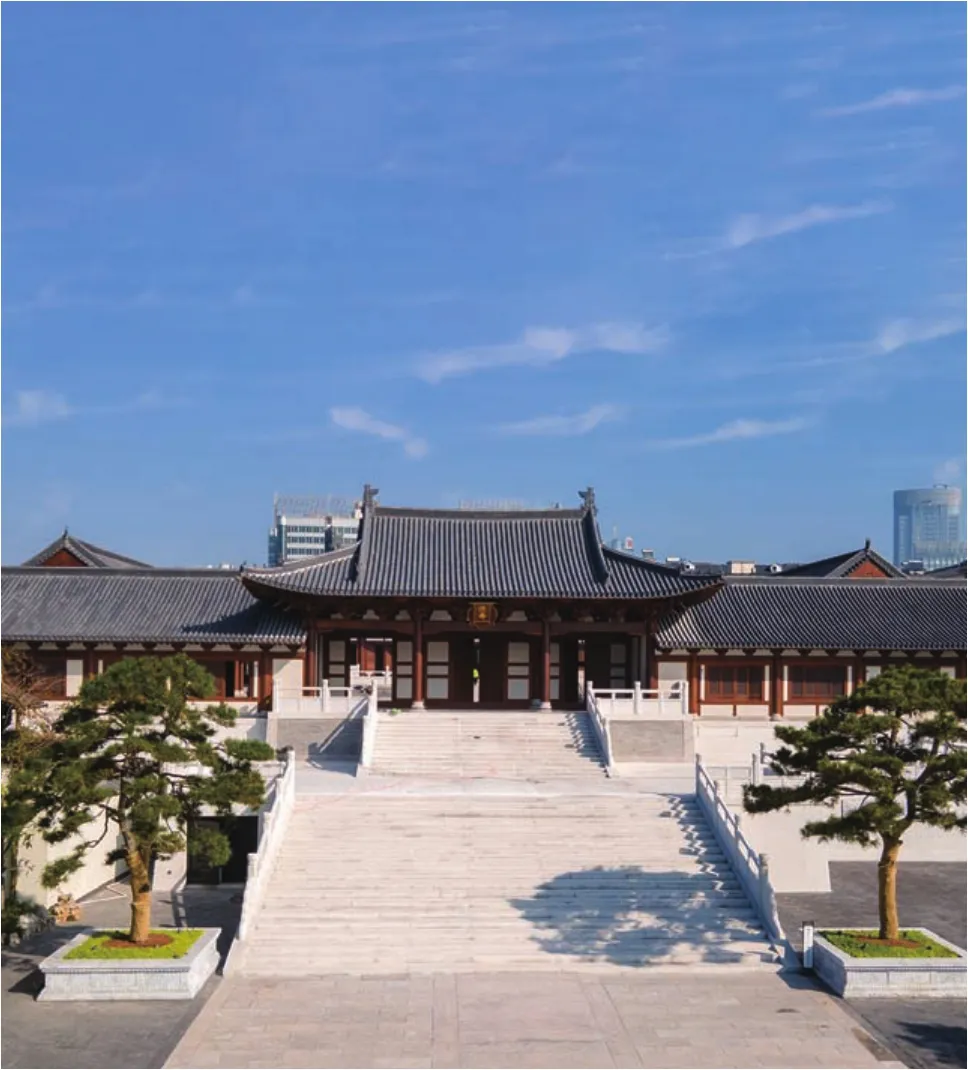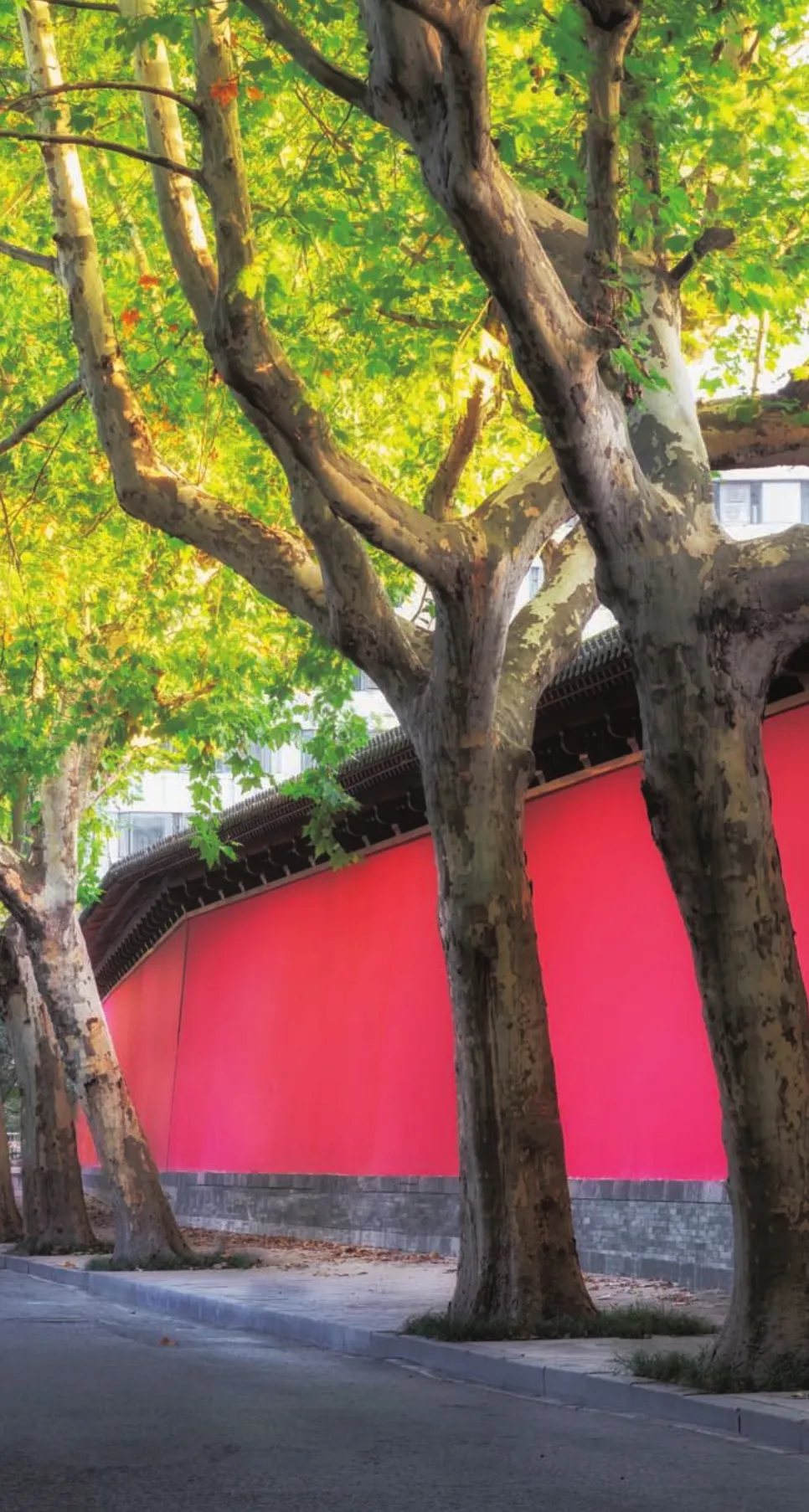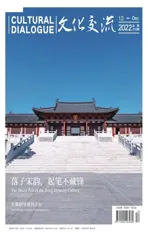宋韵文化,在保护中传承
2023-01-31徐迅雷
文/ 徐迅雷

杭州南宋德寿宫遗址博物馆外的红墙成为一道亮丽风景线。肖奕叁/摄The red walls around the Southern Song Dynasty Deshou Palace Ruins Museum have been attracting throngs of visitors. Photo by Xiao Yisan.
文化要在保护中传承,在传承中发展。
宋韵今辉,一脉相承!11月18日,“2022宋韵文化节开幕暨南宋德寿宫遗址博物馆开馆仪式”在杭州举行。从11月22日起,德寿宫遗址博物馆向公众免费开放,媒体谓之:“红墙灰瓦,采一缕千年宋风,共赴宋韵文化时空之约,用全新的风貌与世人再度相会。”
“宋韵”这个词,是文学化的形象表达,是修辞中的借代,借“宋韵文化”代“宋代文化”,尤其是“南宋文化”。地处杭州城南的“临安城遗址”,正是南宋留给杭州最大的文化遗产。凤凰山麓的宫城、望仙桥东的德寿宫,一南一北,作为皇帝和太上皇帝的活动中心,分别号称“南内”与“北内”,是临安城最具历史象征意义的文化标识。
1984年,德寿宫遗址首次被发现,先后经历4次较大规模的考古发掘。德寿宫原本是宫苑,即宫殿与园林并置,从营造法式看,是典型的江南屋宇与园林的集大成之作。依托考古遗址,德寿宫遗址博物馆于2020年12月开工复建,努力还原宫苑原貌;德寿宫外那一抹“宫墙红”,已然成为杭州新晋网红打卡点。而更珍贵的是,地下考古遗址的保护性展示以及南宋文物的展陈,都在努力展现南宋历史文化的全貌。
南宋德寿宫遗址博物馆地处中河中路以东、望江路以北,南边就是著名的胡雪岩故居。这一地块,对于偌大杭州来说是方寸之地,当初如果被开发了,没有保留下来,那就没有今天的德寿宫遗址博物馆。
作家周华诚新近出版的文化散文《德寿宫八百年》一书,从德寿宫出发,去追寻那远去的南宋风雅,体悟那静水流深的宋韵精髓。其中第一章第一节就写到:“隔着866年的时光,不同的人站在了同一块地面上。这是一块废弃了多年的‘荒地’。很多老杭州人,不一定知道‘德寿宫’,但你若是问他‘杭州工具厂在哪里’,他一定会告诉你确切的方位。杭州工具厂搬离之后,这里就荒着了,年复一年长起了野草。这么一块位于杭州市中心的地块,居然荒芜了许多年,有人对这块地方的内情不甚了解。但现在大家已经知道了—这是块宝地。”
一块宝地为何长时间都是一块“荒地”?就是因为要保护这里地下的历史遗迹,而拒绝了房地产开发。我们不能想象,当初如果这里被开发成了“值钱”的房地产,杭城的“宋韵文化”将会失去多少韵味、韵律和意韵!
没有保护,就没有传承;没有传承,就没有发展。宋代诗人贺亢有名句,“但存方寸地,留与子孙耕”,而今天我们可以说:“但存文化方寸地,留与子孙千秋尊。”

南宋德寿宫遗址博物馆。姚颖康 吕之遥/摄The Southern Song Dynasty Deshou Palace Ruins Museum.Photo by Yao Yingkang and Lyu Zhiyao.
最可怕的就是没文化、不识货,不知道什么是真正重要的宝贝,在“拆拆拆”中与历史文化遗迹“断舍离”。遥想世纪之交,杭州城市建设过程中的“一保一撤”,可谓惊心动魄:
距离德寿宫遗址博物馆不远的河坊街,当年是要拆除的,而且已经开拆,将其从拆改成保,是一个重大而紧急的决定,否则就没有今天熙熙攘攘的具有代表性的杭州老街了。而今天的钱江新城地块,当年正在开建一个大型热电厂,2500 多根桩已经打下去,似乎“木已成舟”,但杭州市下决心撤掉这个热电厂,并为此支付了巨资—试想,如果它建成投产的话,哪有钱江新城,哪有今天的杭州大剧院。
2022年金秋,为纪念北宋《淳化阁帖》刻成1030周年,浙江图书馆古籍部馆内碑廊的《淳化阁帖》刻石,再次进入公众视野。杭州市在1994年将残存的刻石建碑廊予以保护时,并不知道这是最早的汇刻帖的原石,如果没有保护,那真不知后果会如何。
闻一多先生曾经说过:“文化是有惰性的,而愈老的文化,惰性也愈大。”是的,古老文化有点像“惰性气体”,活力往往不够 ;对于历史文化的传承,需要与这样的惰性“拔河”,而保护绝不可有惰性。
文化,沉淀了对真的追求,开启了对美的感知。作为南宋古都,杭州在实施“宋韵文化传世工程”的过程中,当然要“挑大梁”,不断追求“真善美”。追寻南宋风雅,再现宋韵精神,南宋德寿宫遗址博物馆是一个立足点。
Song Yun, Passing on the Legacy through Protection
By Xu Xunlei
On November 18, 2022, the opening ceremony of the 2022 Song Yun Cultural Festival was held in Hangzhou the Southern Song Dynasty Deshou Palace Ruins Museum (also known as the Deshou Palace Museum) was officially unveiled at the same time.Starting on November 22, the Deshou Palace Museum has been open to the public for free.
The term “Song Yun” is a literary expression that serves as a rhetorical device, substituting for “the Song dynasty (960-1279)culture”, particularly “the Southern Song (1127-1279) culture”.“Yun” is a Chinese character that means charm of appeal.

《德寿宫八百年:追寻南宋风雅再现宋韵精髓》,作者周华诚,2022年由浙江人民出版社出版。Deshou Palace in 800 Years: In Search of the Essence of Song Yun, written by Zhou Huacheng and published by Zhejiang People’s Publishing House in 2022.
Located in the south of Hangzhou, the “Lin’an city ruins” is the largest cultural heritage left by the Southern Song dynasty in Hangzhou. The palace city at the foot of the Phoenix Mountain and the Deshou Palace to the east of the Wangxian bridge, one in the south and another in the north, served as the centers of activity for the emperors and the empress dowagers. Known as “Nannei”(the southern inner court) and “Beinei” (the northern inner court) respectively, they are the most historically symbolic cultural landmarks of Lin’an city (present-day Hangzhou).
Similar to the reconstruction of Leifeng Pagoda years ago, the Deshou Palace Museum is also restored and rebuilt on the original site, but it is more of a “museum” than a “restored Deshou Palace”,which is precisely the progress of history.
In 1984, the Deshou Palace ruins were first discovered, and have undergone four large-scale archeological excavations since then. The Deshou Palace was originally a palace garden — a combination of palace and garden, and in terms of construction style, it was a typical masterpiece of Jiangnan (south of the Yangtze River) architecture and gardens. Relying on the archeological site, the construction and restoration of the Deshou Palace Museum began in December 2020, aiming to restore the original appearance of the palace garden. The “palace wall red” has become a popular spot for taking photos and checking in on social media in Hangzhou. What is more precious is that the protective display of underground archeological sites, as well as the display of cultural relics of the Southern Song dynasty, are striving to show the full picture of the history and culture of the Southern Song dynasty.
The Deshou Palace Museum is located east of Zhonghezhong Road and north of Wangjiang Road, and the famous Hu Xueyan’s Former Residence is located in the south. To the great Hangzhou,this is just a tiny plot of land, but if it was originally developed and not preserved, there would be no Deshou Palace Museum today.
Without protection, there is no inheritance; without inheritance, there is no development.
The Hefang Street, not far from the Deshou Palace Museum,was scheduled to be demolished at the time, and had already been partially dismantled. The decision to preserve it instead of tearing it down was a major and urgent one; otherwise, this busy landmark old street in Hangzhou would disappear.
The Qianjiang New City block was originally being developed into a large thermal power plant. More than 2,500 piles had been driven, and the “ship had already been built”, as an old Chinese saying goes. The municipal government decided to scrap the thermal power plant and paid a large sum of money for it. If it had been completed and put into operation, there would be no Qianjiang New City and no Hangzhou Grand Theater today.
Wen Yiduo (1899-1946) once said: “Culture is inert, and the older the culture, the greater the inertia.” Yes, ancient cultures are a bit like “inert gases”, where vitality is often not enough. For the inheritance of history and culture, it is necessary to engage in a “tug of war” with such inertia, and protection cannot be inert.
Culture has precipitated the pursuit of truth and opened up the perception of beauty. As the ancient capital of the Southern Song dynasty, Hangzhou must “choose the best” and continuously pursue “truth, goodness and beauty” in the process of implementing the “Song Yun Cultural Inheritance Project”. The Deshou Palace Museum is a foothold for seeking the refinement of the Southern Song dynasty and reviving the spirit of Song Yun.

与德寿宫一墙之隔的梧桐路。Chinese parasols line the street along the outer walls of the Southern Song Dynasty Deshou Palace Ruins Museum in Hangzhou city, Zhejiang province.
